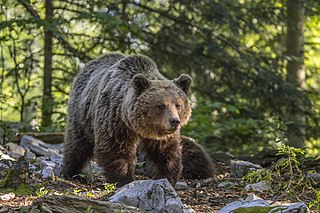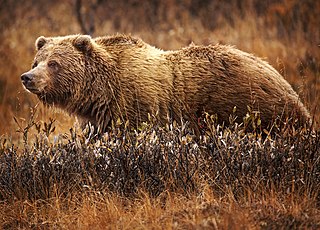
The brown bear is a large bear native to Eurasia and North America. Of the carnivorans, it is rivaled in size only by its closest relative, the polar bear, which is much less variable in size and slightly bigger on average. The brown bear is a sexually dimorphic species, as adult males are larger and more compactly built than females. The fur ranges in color from cream to reddish to dark brown. It has evolved large hump muscles, unique among bears, and paws up to 21 cm (8.3 in) wide and 36 cm (14 in) long, to effectively dig through dirt. Its teeth are similar to those of other bears and reflect its dietary plasticity.

The Yeti is an ape-like creature purported to inhabit the Himalayan mountain range in Asia. In Western popular culture, the creature is commonly referred to as the Abominable Snowman. Many dubious articles have been offered in an attempt to prove the existence of the Yeti, including anecdotal visual sightings, disputed video recordings, photographs, and plaster casts of large footprints. Some of these are speculated or known to be hoaxes.

The California grizzly bear, also known as the California golden bear, is an extinct population of the brown bear, generally known as the grizzly bear. "Grizzly" could have meant "grizzled" – that is, with golden and grey tips of the hair – or "fear-inspiring". Nonetheless, after careful study, naturalist George Ord formally classified it in 1815 – not for its hair, but for its character – as Ursus horribilis. Genetically, North American brown bears are closely related; in size and coloring, the California grizzly bear was much like the Kodiak bear of the southern coast of Alaska. The grizzly became a symbol of the Bear Flag Republic, a moniker that was attached to the short-lived attempt by a group of U.S. settlers to break away from Mexico in 1846. Later, this rebel flag became the basis for the state flag of California, and then California was known as the "Bear State".

The Atlas bear or North African bear was a population of brown bear native to North Africa that became extinct in historical times.

The Eurasian brown bear is one of the most common subspecies of the brown bear, and is found in much of Eurasia. It is also called the European brown bear, common brown bear, common bear, and colloquially by many other names. The genetic diversity of present-day brown bears has been extensively studied over the years and appears to be geographically structured into five main clades based upon analysis of the mtDNA.

An ursid hybrid is an animal with parents from two different species or subspecies of the bear family (Ursidae). Species and subspecies of bear known to have produced offspring with another bear species or subspecies include American black bears, grizzly bears, and polar bears, all of which are members of the genus Ursus. Bears not included in Ursus, such as the giant panda, are expected to be unable to produce hybrids with other bears. The giant panda bear belongs to the genus Ailuropoda.

The Syrian brown bear is a medium-sized and endangered subspecies of Eurasian brown bear native to the Middle East and West-Central Asia, particularly around the Caucasus Mountains.

The Himalayan brown bear, also known as the Himalayan red bear or isabelline bear, is a subspecies of the brown bear occurring in the western Himalayas. It is the largest mammal in the region, males reaching up to 2.2 m long, while females are a little smaller. It is omnivorous and hibernates in dens during the winter.
Endangered mammals of India are the mammal species in India that are listed as threatened in the International Union for Conservation of Nature and Natural Resources (IUCN) Red List of Threatened Animals

The Gobi bear, known in Mongolian as the Mazaalai (Мазаалай), is a subspecies of the brown bear that is found in the Gobi Desert of Mongolia. It is listed as critically endangered by the Mongolian Redbook of Endangered Species and by IUCN standards. Currently, there are only 31 bears left in the Mongolian Gobi Desert; through long-term genetic monitoring it is known that the population is relatively stable, however, the sex ratio is highly skewed towards males. Gobi bears are separated by enough distance from other brown bear populations to achieve reproductive isolation. In 1959, hunting of the animal was prohibited in order to preserve the dying subspecies.

The Kamchatka brown bear, also known as the Far Eastern brown bear, or in Russian: камчатский бурый медведь, romanized: kamchatsky bury medved, is a subspecies of brown bear native to the Russian Kamchatka Peninsula.

The Marsican brown bear, also known as the Apennine brown bear, and orso bruno marsicano in Italian, is a critically endangered population of the Eurasian brown bear, with a range restricted to the Parco Nazionale d'Abruzzo, Lazio e Molise, and the surrounding region in Italy. The Marsican brown bear differs slightly from other brown bears in its appearance and hibernation techniques. The bear's popular name is derived from Marsica, a historic area of the modern-day region of Abruzzo where the bear has long had a significant presence.

Bears have been hunted since prehistoric times for their meat and fur. In addition to being a source of food, in modern times they have been favored by big game hunters due to their size and ferocity. Bear hunting has a vast history throughout Europe and North America, and hunting practices have varied based on location and type of bear.

The Cantabrian brown bear, Iberian brown bear, or Iberian bear is a population of Eurasian brown bears living in the Cantabrian Mountains of Spain.

The grizzly bear, also known as the North American brown bear or simply grizzly, is a population or subspecies of the brown bear inhabiting North America.

The Alaska Peninsula brown bear or "peninsular grizzly" is a colloquial nomenclature for a possible brown bear subspecies that lives in the coastal regions of southern Alaska. It may be a population of the mainland grizzly bear subspecies.

The Mongolian wolf is a subspecies of gray wolf which is native to Mongolia, northern and central China, Korea, and the Ussuri region of Russia.
Formerly or currently considered subspecies or populations of brown bears have been listed as follows:

The brown bear is one of the most omnivorous animals in the world and has been recorded to consume the greatest variety of foods of any bear. Throughout life, this species is regularly curious about the potential of eating virtually any organism or object that they encounter. Certainly no other animal in their given ecosystems, short perhaps of other bear species and humans, can claim to feed on as broad a range of dietary opportunities. Food that is both abundant and easily obtained is preferred. Their jaw structure has evolved to fit their dietary habits. Their diet varies enormously throughout their differing areas based on opportunity. In spring, winter-provided carrion, grasses, shoots, sedges and forbs are the dietary mainstays for brown bears from almost every part of their distribution. Fruits, including berries, become increasingly important during summer and early autumn. Roots and bulbs become critical in autumn for some inland bear populations if fruit crops are poor. The dietary variability is illustrated in the western United States, as meat made up 51% of the average year-around diet for grizzly bears from Yellowstone National Park, while it made up only 11% of the year-around diet for grizzlies from Glacier National Park a few hundred miles to the north.




















